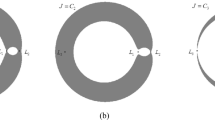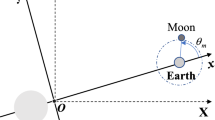Abstract
The Earth–Moon L1 libration point is proposed as a human gateway for space transportation system of the future. This paper studies indirect transfer using the perturbed stable manifold and lunar flyby to the Earth–Moon L1 libration point. Although traditional studies indicate that indirect transfer to the Earth–Moon L1 libration point does not save much fuel, this study shows that energy efficient indirect transfer using the perturbed stable manifold and lunar flyby could be constructed in an elegant way. The design process is given to construct indirect transfer to the Earth–Moon L1 libration point. Simulation results show that indirect transfer to the Earth–Moon L1 libration point saves about 420 m/s maneuver velocity compared to direct transfer, although the flight time is about 20 days longer.
Similar content being viewed by others
References
Alessi E.M., Gomez G., Masdemont J.J.: Leaving the Moon by means of invariant manifolds of libration point orbits. Commun. Nonlinear Sci. Numer. Simul. 14(12), 4153–4167 (2008a)
Alessi, E.M., Gomez, G., Masdemont, J.J.: LEO-Lissajous transfers in the Earth–Moon system. In: 59th International Astronautical Federation congress, Paper No. IAC08-C1.3.7 (2008b)
Belbruno E., Miller J.: Sun-perturbed Earth-to-Moon transfers with ballistic capture. J. Guidance Control Dyn. 16(4), 770–775 (1993)
Bernelli-Zazzera, F., Topputo, F., Massari, M.: Assessment of mission design including utilization of libration points and weak stability boundaries. Ariadna Study id: 03/4103 (2004)
Circi C., Teofilatto P.: On the dynamics of weak stability boundary lunar transfers. Celest. Mech. Dyn. Astron. 79(1), 41–72 (2001)
Davis K.E., Anderson R.L., Scheeres D.J., Born G.H.: The use of invariant manifolds for transfers between unstable periodic orbits of different energies. Celest. Mech. Dyn. Astron. 107, 471–485 (2010)
Farquhar R.W., Dunham D.W., Yanping Guo , McAdams J.V.: Utilization of libration points for human exploration in the Sun–Earth–Moon system and beyond. Acta Astronautica. 55, 687–700 (2004)
Garcia F., Gomez G.: A note on weak stability boundaries. Celestial Mech. Dyn. Astr. 97(2), 87–100 (2007)
Gomez G., Jorba A., Masdemont J., Simò C.: Study of the transfer from the Earth to a halo orbit around the equilibrium point L1. Celest. Mech. Dyn. Astron. 56(4), 541–562 (1993)
Gordon, D.P.: Transfers to Earth–Moon L2 halo orbits using lunar proximity and invariant manifolds. M.S. Thesis, Purdue University (2008)
Koon W., Lo M., Marsden J., Ross S.: Low energy transfer to the Moon. Celest. Mech. Dyn. Astron. 81(1), 63–73 (2001)
Li M., Zheng J.: Impulsive lunar halo transfers using the stable manifolds and lunar flybys. Acta Astronautic 66, 1481–1492 (2010)
Lo, M.W., Chung, M.J.: Lunar sample return via the interplanetary superhighway. In: AIAA/AAS Astrodynamics Specialist Conference, California (2002)
Lo, M.W., Ross, S.D.: The lunar L1 gateway: Portal to the stars and beyond. In: Proceedings of the AIAA Space 2001 Conference, Albuquerque (2001)
Parker, J.S.: Families of low-energy lunar halo transfers. AAS/AIAA Spaceflight Dynamics Conference, AAS 06-132 (2006)
Parker, J.S., Born, G.H.: Direct lunar halo orbit transfers. AAS/AIAA Spaceflight Mechanics Conference, AAS 07-229 (2007)
Parker, J.S., Lo, M.W.: Shoot the Moon 3D. AIAA/AAS Astrodynamics Specialist Conference, AIAA 2005-383 (2005)
Perozzi E., Di Salvo A.: Novel spaceways for reaching the Moon: an assessment for exploration. Celest. Mech. Dyn. Astron. 102(1–3), 207–218 (2008)
Rausch, R.R.: Earth to halo orbit transfer trajectories. M.S. Thesis, Purdue University (2005)
Romagnoli D., Circi C.: Earth–Moon weak stability boundaries in the restricted three and four body problem. Celest. Mech. Dyn.Astron. 103, 79–103 (2009)
Wilson R.S., Howell K.C.: Trajectory design in the Sun–Earth–Moon system using lunar gravity assists. J. Spacecr. Rockets 35(2), 191–198 (1998)
Yagasaki K.: Sun-perturbed Earth-to-Moon transfers with low energy and moderate flight time. Celest. Mech. Dyn. Astron. 90(3/4), 197–212 (2004)
Author information
Authors and Affiliations
Corresponding author
Rights and permissions
About this article
Cite this article
Li, M., Zheng, J. Indirect transfer to the Earth–Moon L1 libration point. Celest Mech Dyn Astr 108, 203–213 (2010). https://doi.org/10.1007/s10569-010-9301-7
Received:
Revised:
Accepted:
Published:
Issue Date:
DOI: https://doi.org/10.1007/s10569-010-9301-7




